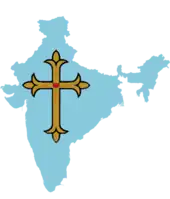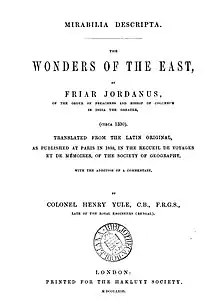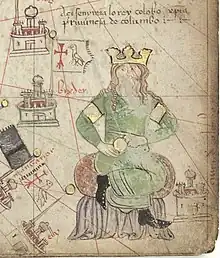Jordanus
Jordanus (fl. 1280-c. 1330), distinguished as Jordan of Severac (Latin: Iordanus de Severaco; Occitan: Jordan de Severac; French: Jourdain de Séverac; Italian: Giordano di Séverac) or Jordan of Catalonia (Latin: Jordanus Catalanus; Catalan: Jordà de Catalunya), was a Catalan[lower-alpha 1] Dominican missionary and explorer in Asia known for his Mirabilia Descripta describing the marvels of the East. He was the first bishop of the Roman Catholic Diocese of Quilon, the first Roman Catholic diocese in the Indian subcontinent.
Jordan of Severac | |
|---|---|
| The first Roman Catholic bishop in India (Bishop of Quilon India) |
| Part of a series on |
| Christianity in India |
|---|
 |
Travels
_and_King_of_Vijayanagar_(bottom)_in_the_Catalan_Atlas_of_1375.jpg.webp)
Jordanus was perhaps born at Sévérac-le-Château, north-east of Toulouse. Possibly a disciple of Jerome de Catalonia, also known as Hieronymus Catalani,[5] in 1302 Jordanus may have accompanied St Thomas of Tolentino, via Negropont, to the East; but it is only in 1321 that we definitely discover him in western India, in the company of Thomas and his companions. Ill-luck detained them at Thane in Salsette Island, near Bombay; and here Jordanus's companions were killed on 8 and 11 April 1321.
Jordanus, escaping, worked some time at Bharuch, in Gujarat, near the Narmada estuary, and at Suvali near Surat; to his fellow-Dominicans in north Persia he wrote two letters – the first from Gogo in Gujarat (12 October 1321), the second from Thane (24 January 1323/4) describing the progress of this new mission. From these letters we learn that Roman attention had already been directed, not only to the Bombay region, but also to the extreme south of the Indian peninsula, especially to Columbum, Quilon or Kollam in later Travancore; Jordanus' words may imply that he had already started a mission there before October 1321.

From Catholic traders Jordanus had learnt that Ethiopia (i.e. Abyssinia and Nubia) was accessible to Western Europeans; at this very time, as we know from other sources, the earliest Latin missionaries penetrated thither. Finally, the Epistles of Jordanus, like the contemporary Secreta of Marino Sanuto (1306–1321), urge the Pope to establish a Christian fleet upon the Indian seas.
Jordanus, between 1324 and 1328 (if not earlier), probably visited Kollam and selected it as the best centre for his future work; it would also appear that he revisited Europe about 1328, passing through Persia, and perhaps touching at the great Crimean port of Soidaia or Sudak. He was appointed a bishop in 1328 and nominated by Pope John XXII in his bull Venerabili Fratri Jordano to the see of Columbum or Kollam (Quilon) on 21 August 1329. This diocese was the first Roman Catholic one in the whole of the Indies, with jurisdiction over modern India, Pakistan, Afghanistan, Bangladesh, Burma, and Sri Lanka. It was created on 9 August by the decree Romanus Pontifix. Together with the new bishop of Samarkand, Thomas of Mancasola, Jordanus was commissioned to take the pallium to John de Cora, archbishop of Sultaniyah in Persia, within whose province Kollam was reckoned; he was also commended to the Christians of south India, both east and west of Cape Comorin, by Pope John.
Mirabilia Descripta

Either before going out to Malabar as bishop, or during a later visit to the west, Jordanus probably wrote his Mirabilia, which from internal evidence can only be fixed within the period 1329–1338; in this work he furnished the best account of Indian regions, products, climate, manners, customs, fauna and flora given by any European in the Middle Ages — superior even to Marco Polo's.

In his triple division of the Indies, India Major comprises the shorelands from Malabar to Cochin China; while India Minor stretches from Sind (or perhaps from Baluchistan) to Malabar; and India Tertia (evidently dominated by African conceptions in his mind) includes a vast undefined coast-region west of Baluchistan, reaching into the neighborhood of, but not including, Ethiopia and Prester John's domain. Jordanus' Mirabilia contains the earliest clear African identification of Prester John, and what is perhaps the first notice of the Black Sea under that name; it refers to the author's residence in India Major and especially at Kollam, as well as to his travels in Armenia, north-west Persia, the Lake Van region, and Chaldaea; and it supplies excellent descriptions of Parsee doctrines and burial customs, of Hindu ox-worship, idol-ritual, and suttee, and of Indian fruits, birds, animals and insects. After 8 April 1330 we have no more knowledge of Bishop Jordanus I.
Extracts of Mirabilia Descripta
.jpg.webp) Catholic critical account of Saint Thomas Christians in India, written by Jordanus in 1329–1338 in Mirabilia Descripta.[6]
Catholic critical account of Saint Thomas Christians in India, written by Jordanus in 1329–1338 in Mirabilia Descripta.[6].jpg.webp) Original facsimile extracts from the unique manuscript of Jordanus, Mirabilia descripta (1329–1338)
Original facsimile extracts from the unique manuscript of Jordanus, Mirabilia descripta (1329–1338).jpg.webp) Jordanus, on the destructions of the "Turkish Saracens" in India (Mirabilia Descripta, written in 1329–1338).[7][8]
Jordanus, on the destructions of the "Turkish Saracens" in India (Mirabilia Descripta, written in 1329–1338).[7][8]
References
- Liščák, Vladimír (2017). "Mapa mondi (Catalan Atlas of 1375), Majorcan cartographic school, and 14th century Asia" (PDF). International Cartographic Association: 4–5.
- Massing, Jean Michel; Albuquerque, Luís de; Brown, Jonathan; González, J. J. Martín (1991). Circa 1492: Art in the Age of Exploration. Yale University Press. ISBN 978-0-300-05167-4.
- Cartography between Christian Europe and the Arabic-Islamic World, 1100–1500: Divergent Traditions. Brill. 2021. p. 176. ISBN 978-90-04-44603-8.
- Liščák, Vladimír (2017). "Mapa mondi (Catalan Atlas of 1375), Majorcan cartographic school, and 14th century Asia" (PDF). International Cartographic Association: 5.
- "Meravelles descrites".
- Jordanus, Catalani; Yule, Henry; Parr, Charles McKew donor; Parr, Ruth (1863). Mirabilia descripta : the wonders of the East. London : Printed for the Hakluyt Society. p. 23, paragraph 31.
- Jordanus, Catalani; Yule, Henry; Parr, Charles McKew donor; Parr, Ruth (1863). Mirabilia descripta : the wonders of the East. London : Printed for the Hakluyt Society. p. 23.
- Juncu, Meera (30 July 2015). India in the Italian Renaissance: Visions of a Contemporary Pagan World 1300-1600. Routledge. p. 85. ISBN 978-1-317-44768-9.
Primary sources
Of Jordanus' Epistles there is only one MS., viz. Paris, National Library, 5006 Lat., fol. 182, r. and v.; of the Mirabilia also one MS. only, viz. London, British Library, Additional MSS., 19513, fols. 3, r.f 2 r.
- The text of the Epistles is in Quétif–Échard, Scriptores ordinis praedicatorum, i. 549–550 (Epistle I.)
- and in Luke Wadding, Annales minorum, vi. 359–361 (Epistle II.)
- Latin text of the Mirabilia: "Description des Merveilles d'une partie de l'Asie par le P. Jordan ou Jourdain Catalani". Recueil de Voyages et de Mémoires par la Société Géographie Volume 4 (in French and Latin). Paris: Arthus-Bertrand. 1839. pp. 1–68.
- English translation of the Mirabilia as The Wonders of the East.
- The Papal letters referring to Jordanus are in Odericus Raynaldus, Annales ecclesiastici, 1330, f lv. and lvii (8 April; 14 February).
Secondary sources
- Yule, Henry, ed. and trans. (1863). Mirabilia descripta: the wonders of the East. London: Hakuyt Society.
{{cite book}}: CS1 maint: multiple names: authors list (link) - Yule, Henry (1913). "Additional notes and corrections to the translation of the Mirabilia of Friar Jordanus". Cathay and the way thither: being a collection of medieval notices of China (Volume 3). London: Hakluyt Society. pp. 39–44.
- Henry Yule's Cathay, giving a version of the Epistles, with a commentary, &c. (Hakluyt Society, 1866) pp. 184–185, 192–196, 225–230
- Kurdian, H. (1937). "A correction to 'Mirabilia Descripta' (The Wonders of the East). By Friar Jordanus circa 1330". Journal of the Royal Asiatic Society. 69 (3): 480–481. doi:10.1017/S0035869X00086032. S2CID 163202845.
- F. Kunstmann, Die Mission in Meliapor und Tana und die Mission in Columbo in the Historisch-politische Blätter of Phillips and Görres, xxxvii. 2538, 135–152 (Munich, 1856), &c.
- Beazley, C.R. (1906). The Dawn of Modern Geography (Volume 3). Oxford: Clarendon Press. pp. 215–235.
- This article incorporates text from a publication now in the public domain: Beazley, Charles Raymond (1911). "Jordanus". In Chisholm, Hugh (ed.). Encyclopædia Britannica. Vol. 15 (11th ed.). Cambridge University Press. p. 512.